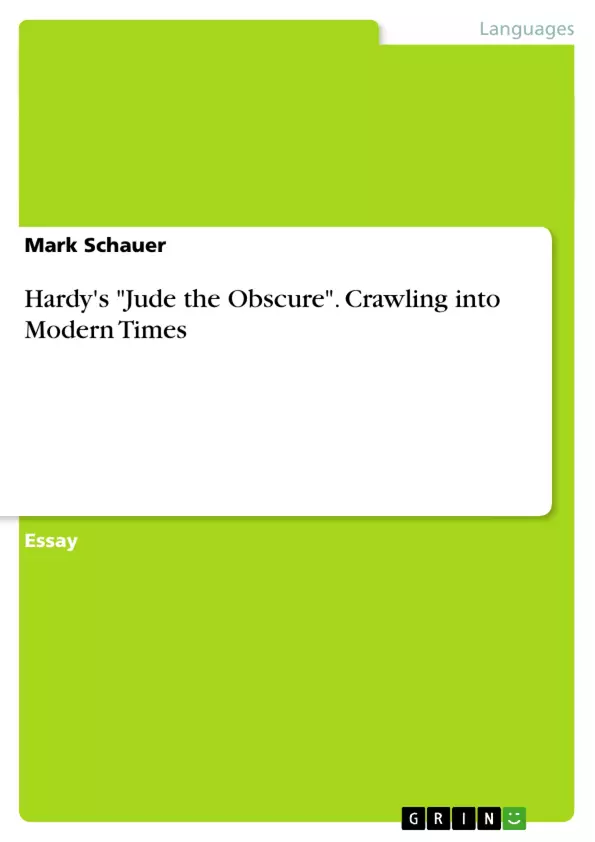Thomas Hardy is often identified as a transitional figure between the Victorian and Modern eras, and, as Gossin has said, Hardy’s 1895 novel Jude the Obscure, “fashioned a fictional narrative mode that closely resonates with what Alan Velie has identified as, ‘perhaps the most common form of narrative in modern fiction’— ironedy” (Gossin 224). In synthesizing this new style of ironic comedy, Hardy simultaneously transformed both the gothic and bildungsroman genres of literature, giving English literature a remarkably influential addition to the canon. Jude Fawley was himself sui generis for a story that was predominately one of terror gothic, for the genre had long been associated with female writers and lead characters. Though male authors and lead characters became prominent in gothic’s second wave in the 1880s, the male characters were usually depicted in effeminate ways— Stevenson’s home-bound Dr. Jekyll, for instance, or Wilde’s aesthetic Dorian Gray—and female characters were almost completely absent from the narratives. Jude, on the other hand, was the first convincingly heterosexual man in the genre to explicitly fall victim to a patriarchal society.
Inhaltsverzeichnis (Table of Contents)
- Schauer
- Jude Fawley
- Schauer
- Schauer
- Schauer
Zielsetzung und Themenschwerpunkte (Objectives and Key Themes)
This preview provides a comprehensive overview of Thomas Hardy's novel Jude the Obscure, exploring its significance as a transitional work between the Victorian and Modern eras. Through a detailed examination of its Gothic and Bildungsroman elements, the preview will delve into the novel's groundbreaking representation of a male protagonist who falls victim to a patriarchal society.
- The novel's status as a Gothic novel is assured by its adherence to various conventions of the genre, including incestuous relationships and the presence of a doppelganger.
- The text explores the societal limitations and rigid gender expectations that impact Jude and Sue's lives.
- Despite the bleak fate of the protagonists, Hardy employs ironic humor and explores themes of colonialism in a unique way.
- The novel's significance as a Bildungsroman is explored through the contrasting experiences of Jude and Sue.
- The preview highlights the novel's lasting influence and its groundbreaking representation of the struggles of the working class within a patriarchal society.
Zusammenfassung der Kapitel (Chapter Summaries)
The first chapter of the novel, "Schauer," introduces the reader to the complex and tragic story of Jude Fawley, a working-class man who aspires to a life of education and intellectual pursuits. He is portrayed as a complex and contradictory character, displaying both feminine and masculine traits, making him a unique figure in the gothic genre. Jude's struggle for intellectual and social mobility is hampered by the rigid class and gender structures of Victorian society. He is ostracized for his aspirations and ultimately faces a tragic fate.
The second chapter, "Schauer," delves deeper into the intricate relationship between Jude and Sue Bridehead, exploring the societal constraints and rigid gender expectations that define their lives. Sue, like Jude, possesses intellectual and social aspirations that are stifled by the patriarchal norms of their time. Their desire for a more egalitarian relationship faces significant challenges, ultimately contributing to their downfall.
The third chapter, "Schauer," shifts the narrative focus towards the unconventional nature of Jude and Sue's relationship, highlighting the presence of ironic humor within the novel. Hardy's use of humor, particularly in the character of Arabella, is considered daring for its time. The chapter also introduces the intriguing concept of colonialism through the character of Little Father Time, providing a unique perspective for its time. The novel's representation of colonialism in this way contrasts with other works like Dracula and Heart of Darkness, adding another layer of complexity to the story.
Schlüsselwörter (Keywords)
Key themes and concepts explored in Jude the Obscure include the Gothic genre, Bildungsroman, patriarchal society, class structures, gender expectations, ironic humor, colonialism, and the representation of the working class in literature. The novel examines the impact of societal limitations on individuals, particularly those seeking intellectual and social mobility within a rigid and often oppressive system.
- Quote paper
- Mark Schauer (Author), 2012, Hardy's "Jude the Obscure". Crawling into Modern Times, Munich, GRIN Verlag, https://www.grin.com/document/230275



